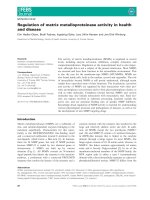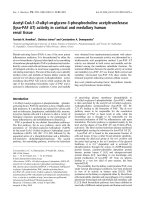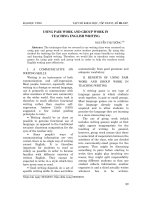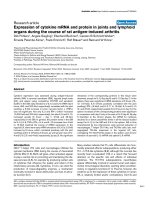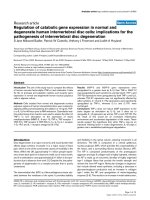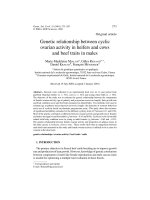Regulation of sla2p by activity in endocytosis and actin organization by the ark1 prk1 family of kinases
Bạn đang xem bản rút gọn của tài liệu. Xem và tải ngay bản đầy đủ của tài liệu tại đây (6.33 MB, 180 trang )
i
Regulation of Sla2p activity in endocytosis
and actin organization by the Ark1/Prk1
family of kinases
NEEYOR BOSE (B.Sc Hons)
NATIONAL UNIVERSITY OF SINGAPORE
ii
ACKNOWLEDGEMENTS
“To go through the hardest journey, we need only take one step at a time, but we must
keep on stepping”- Chinese proverb
At each of my steps, there have been those who’ve helped me, without whom there
would be no next step. My heartfelt gratitude goes out to you all.
To Asst/P Yeong Foong May and A/P Uttam Surrana: Thank you for rescuing
me during a very difficult time and helping me get this far. Dr Yeong, I am deeply
grateful for your generosity of time and effort that made this thesis happen.
To A/P Cai Ming Jie for giving me the opportunity to pursue my graduate
studies.
To the former members of CMJ lab: for creating a nurturing and collaborative
environment. We began as colleagues but now I am lucky to have you as friends.
Thank you all for your support and kindness over the years.
To my committee members A/P Edward Manser and A/P Wang Yue: Thank
you for nudging me on to the right track and the annual reality checks.
To my dear friends Desmond, Karen, Bin, Shal, Bea, Mann, Chris, Ajay, Xian
Wen: for always listening, caring and letting me mess up your shoulders with my
tears and pointing me towards the direction of the proverbial light at the end of the
tunnel. It seems most inadequate to say that I couldn’t have done it without you.
To Ma and Baba: for never letting “home” be too far away. Thank you for
enveloping me with a sense of security and warmth. I always knew I was very lucky, I
now realize how much.
To Runtoo: for caring so very much. It was the pep talk that really drove it
home.
To Vinod: for bringing me back to life. Thank you for stepping with me, for
picking me up at every stumble and for never letting me go alone.
Above all, I thank God- for giving me so much to be thankful for.
Neeyor Bose,
August 2008
iii
TABLE OF CONTENTS
ACKNOWLEDGEMENT ii
TABLE OF CONTENTS iv
SUMMARY vi
LIST OF FIGURES viii
LIST OF TABLES ix
LIST OF ABBREVIATIONS sx
1. INTRODUCTION 2
1.1ACTIN CYTOSKELETON 2
1.1.1 Actin cytoskeleton in yeast 3
1.1.2 Assembly of actin at cortical patches 5
1.1.2.1 Arp2/3 complex 5
1.1.2.2 Nucleation promoting factors 7
1.1.3 Components of actin patches and proteins associated with them 11
1.1.4 Dynamics of actin patches and their associated proteins 12
1.1.5 Other actin structures in yeast 15
1.1.5.1 Actin cables 15
1.1.5.2 Acto-myosin ring 16
1.2 ENDOCYTOSIS 17
1.2.1 Clathrin mediated endocytosis 17
1.2.2 Endocytic Coat Proteins 20
1.2.2.1 Clathrin 20
1.2.2.2 Sla1p 20
1.2.2.3 Pan1p 21
1.2.2.4 yAP1801 and yAP1802 22
1.2.2.5 Ent1p and Ent2p 22
1.2.2.6 Scd5p 23
1.2.2.7 Sla2p/HIP1/R 23
1.2.2.7.1 Sla2p 23
1.2.2.7.2 HIP1 and HIP1R 27
1.2.2.8 Vesicle Scission 30
1.2.2.9 Proteins regulating Clathrin-mediated endocytosis 33
1.2.3 Endocytic Signals 36
1.2.4 Role of actin dynamics in endocytosis 37
1.3 ACTIN AND ENDOCYTOSIS IN HIGHER EUKARYOTES 39
1.3.1 Clathrin-mediated endocytosis in higher eukaryotes 40
1.3.2 Caveolae-mediated endocytosis 42
1.3.3 Macropinocytosis 43
1.3.4 Phagocytosis 43
1.4 OBJECTIVES 45
2. MATERIALS AND METHODS 46
2.1 MATERIALS 47
2.1.1 Strains 47
2.1.2 Plasmids 48
2.1.3 Antibodies and Reagents 52
ANTIBODIES 52
SOURCE 52
2.2 CULTURE CONDITIONS 53
2.3 RECOMBINANT DNA TECHNOLOGY 53
2.3.1 DNA transformation of E.coli cells 54
2.3.2 Plasmid DNA preparation 55
2.3.3 Site-directed mutagenesis 55
2.4 YEAST GENETIC MANIPULATIONS 56
2.4.1 Yeast transformation and integration 56
2.4.2 Gene disruptions and manipulation 57
iv
2.5 YEAST CELL BIOLOGY PROTOCOLS 57
2.5.1 Yeast two-hybrid assay 57
2.5.2 Endocytosis assays 58
2.5.2.1 Lucifer Yellow uptake 58
2.5.2.2 FM4-64 uptake and pulse-chase assay 58
2.5.2.3 Fur4p uptake assay 59
2.5.3 Drop test 60
2.6 FLUORESCENT MICROSCOPY 60
2.6.1 Fixing and staining with rhodamine phalloidin 60
2.6.1 Live-cell, time lapse microscopy 60
2.7 PROTEIN ANALYSIS 61
2.7.1 Crude yeast protein extract 61
2.7.2 Immunoprecipitation and western blot 62
2.7.3 Purification of GST- and His-tagged proteins and in vitro binding assays 63
2.7.4 GST pull down assay 64
2.7.5 In vitro kinase assay 65
2.7.6 In vitro phosphatase assay 65
3. PHOSPHOREGULATION OF SLA2P 67
3.1 BACKGROUND 68
3.2 SLA2P IS A SUBSTRATE OF PRK1P KINASE 69
3.2.1 Identification of Prk1p phosphorylation through p sequence analysis 69
3.2.2 Sla2p is a substrate of Prk1p in vitro 71
3.2.3 Sla2p is a phosphorylated protein in vivo and is likely to be exclusively phosphorylated by
the Ark1/Prk1 family of kinases 71
3.3 PHOSPHORYLATION OF SLA2P AFFECTS ITS FUNCTION AT THE CELL CORTEX 72
3.3.1 Localization and patch dynamics of Sla2p is affected by phosphorylation 72
3.3.2 Localization and patch dynamics of other endocytic proteins are affected by
phosphorylation of Sla2p 74
3.3.3 Sla2p phospho-status affects receptor-mediated but not fluid-phase endocytosis 82
3.3.4 Sla2p’s phosphorylation affects its interaction with some of interacting partners but not
others 83
3.4 SLA2P INTERACTS WITH SCD5P AND CAN BE DEPHOSPHORYLATED BY THE PROTEIN PHOSPHATASE-
1, G
LC7P 88
3.4.1 Sla2p and Scd5p interact with each other using their C-terminal and N-terminal regions
respectively 89
3.4.2 Glc7p can dephosphorylate Sla2p, both in vitro as well as in vivo 89
3.5 DISCUSSION 92
3.6 FUTURE WORK AND PERSPECTIVES 97
4. SECOND COILED-COIL DOMAIN OF SLA2P PLAYS A VITAL ROLE IN ITS
FUNCTION 100
4.1 BACKGROUND 101
4.2 SLA2P C-TERMINAL COILED-COIL DOMAIN IS IMPORTANT FOR ITS FUNCTION 102
4.2.1 Deletion of second coiled-coil domain (amino acid 700-730) causes temperature sensitivity
102
4.2.2 Localization and dynamics of C-terminal truncation mutants are different from wild-type
Sla2p 105
4.2.3 Actin organization and endocytosis is aberrant in some of the C-terminal deletion mutants
105
4.3 SLA2P C-TERMINAL COILED-COIL MEDIATES INTERACTION WITH ARK1P AND SCD5P AND AFFECTS
THEIR LOCALIZATION
110
4.3.1 Sla2p and Ark1p interaction domain analysis 110
4.3.2 Sla2p and Scd5p interaction domain analysis 114
4.3.3 Sla2p C-terminal affects localization and dynamics of Ark1p 116
4.3.4 Localization and dynamics of Scd5p in sla2 mutants 116
4.4 DISCUSSION 117
4.4.1 Relevance of the Sla2p C-terminal region 117
4.4.2 Phenotype of sla2
CC mutant 119
4.4.3 Sla2p’s second coiled-coil domain is essential for interaction with Ark1p and Scd5p 123
v
4.5 FUTURE WORK AND PERSPECTIVES 124
5. SLA2P AND ABP1P 127
5.1 BACKGROUND 128
5.2 HIGH COPY SUPPRESSOR SCREEN OF SLA2CC MUTANT 128
5.2.1 Identification and verification of suppressors 128
5.3 ABP1 IDENTIFIED AS A HIGH COPY SUPPRESSOR OF THE SLA2CC MUTANT 131
5.3.1 High concentration of ABP1 can suppress the growth defects of the sla2
CC mutant 131
5.3.2 High concentration of ABP1 can rescue actin defects of the sla2
CC mutant 131
5.2.3 High concentration of ABP1 can rescue endocytic defects of the sla2
CC mutant 134
5.3.4 Physical interaction between Sla2p and Abp1p 137
5.4 DISCUSSION 139
5.4.1 Over-expression suppression screen 139
5.4.2 ABP1 is an extragenic high-copy suppressor of the sla2
CC mutant 140
5.5 FUTURE WORK AND PERSPECTIVES 142
6. CONCLUSIONS 143
vi
SUMMARY
The actin cytoskeleton plays a central role in endocytosis in Saccharomyces
cerevisiae. Sla2p is an interesting adaptor molecule that is involved in both these
processes and is a vital link between them. Deletion of this protein causes massive
accumulation of actin at the cortex as well as a complete block in endocytosis. Sla2p
negatively regulates actin polymerization by inhibiting Pan1p, an activator of the
Arp2/3 nucleator. However, the regulation of this process is poorly understood.
In this study I show that Sla2p is subjected to phosphorylation by Prk1p and
possibly Ark1p kinase. These kinases constitute a unique family of actin regulating
kinase whose substrates include many components of actin machinery as well as
endocytic and membrane trafficking pathways. The phosphorylation on Sla2p exerts
subtle regulatory effects leading to longer lifespan at the cortex and endocytic defects
and also changes Sla2p’s affinity for Scd5p and Pan1p. I also show that Sla2p can be
dephosphorylated by the Scd5p/Glc7p complex, in a manner similar to what is
reported for Pan1p. I postulate that this regulatory cycle is important for function of
Sla2p in endocytosis and actin organization.
Secondly, I studied the C-terminal portion of Sla2p, which contains two
additional coiled-coil domains along with an F-actin binding THATCH domain. I
found that the C-terminal region of Sla2p is important for binding Ark1p and Scd5p,
while the second coiled-coil domain starting from 700 till 730 amino acids is
necessary for both these interactions. Deletion of this short domain causes severe
temperature sensitivity, actin aberrations and a complete block in endocytosis. I also
made a series of truncations in the C-terminal region of Sla2p and studied the effects
of such mutations. Different truncations gave different phenotypes while the strongest
phenotype was obtained by deleting just the 30 amino acids constituting the coiled-
vii
coil domain (sla2
CC mutant). I hypothesize that this particular allele is toxic
because the 30 amino acids contains a part of the upstream helical domain that
regulates binding to F-actin.
Thirdly, I performed a high-copy suppressor screening and found that over
expressing Abp1p can rescue the temperature sensitivity of sla2
CC. In addition to
growth, overexpressing Abp1p can also rescue actin aberrations such as actin clumps
and bars seen in the mutant. Receptor-mediated and fluid-phase endocytosis are also
significantly improved in cells containing high-copy number plasmid with ABP1 but
not in mutant cells containing empty plasmid. No deleterious effects were observed
upon overexpression of Abp1p in wild-type cells.
viii
LIST OF FIGURES
Figure 1.1 Schematic of actin polymerization 3
Figure 1.2 Yeast cytoskeleton through cell cycle 4
Figure 1.3 Structure and function of Arp2/3 complex 6
Figure 1.4 Domain organization of nucleation-promoting factors in yeast 8
Figure 1.5 Endocytic patch maturation and sequence of coat-protein
assembly
15
Figure 1.6 Types of endocytosis in yeast and mammalian cells 19
Figure 1.7 Complex between Pan1p, Sla1p, End3p and Scd5p 21
Figure 1.8 Schematic diagram representing Sla2p domains 25
Figure 1.9 Domain architecture of HIP1 andHIP1R 27
Figure 1.10 Structure of Prk1p kinase 34
Figure 1.11 Types of endocytosis in higher eukaryotes 40
Figure 2.1 Schematic of site-directed mutagenesis 56
Figure 3.1 Sla2p is a substrate of Prk1 both in vitro and in vivo 70
Figure 3.2 Lifespan of Sla2p depends on phosphorylation 77
Figure 3.3 Lifespan of Abp1p depends on phosphorylation state of Sla2p 78
Figure 3.4 Lifespan of Pan1p depends on phosphorylation state of Sla2p 79
Figure 3.5 Lifespan of Sla1p depends on phosphorylation state of Sla2p 80
Figure 3.6 Lifespan of Ark1p depends on phosphorylation state of Sla2p 81
Figure 3.7 Effect of Sla2p phosphorylation on endocytosis and actin
organization
85
Figure 3.8 Effect of Sla2p phosphorylation on interaction with binding
partners
87
Figure 3.9 Sla2p can be dephosphorylated by Glc7p both in vitro and in
vivo
91
Figure 3.10 Proposed model explaining effects of phosphorylation and
dephosphorylation of Sla2p
96
Figure 4.1 Coiled-coil domains of Sla2p 101
Figure 4.2 Growth and localization of Sla2p C-terminal truncation mutants 104
Figure 4.3 Effect of Sla2p C-terminal truncation on endocytosis and actin
organization
108
Figure 4.4 Localization and dynamics of Ark1p in Sla2p mutants 113
Figure 4.5 Interaction between Scd5p and Sla2p 115
Figure 4.6 Instrasteric inhibition of actin binding by the upstream helical
domain
121
Figure 4.7 I/LWEQ superfamily 122
Figure 5.1 Overexpression of Abp1p rescues growth defects of sla2DCC 133
Figure 5.2 Overexpression of Abp1p rescues endocytic defects of sla2DCC 136
Figure 5.3 Interaction between Abp1p and Sla2p 138
ix
LIST OF TABLES
Table 2.1 List of Strains 47
Table 2.2 List of Plasmids 49
Table 2.3 List of Antibodies 52
Table 5.1 Result of high-copy suppressor screen 130
x
LIST OF ABBREVIATIONS
a.a. or aa amino acid
Abp1p actin-binding protein 1
ADF actin depolymerizing factor
ADF-H actin depolymerizing factor homologous region
ADP adenosine 5’-diphosphate
ALP alkaline phosphatase
AMP adenosine 5’-monophosphate
ANTH AP180 N-terminal Homology
ARK actin-regulating kinase
ATP adenosine 5'-triphosphate
AP-1/2/3 adaptor protein-1/2/3
BAR BIN-amphiphysin-RVS domain
bp base pair
BSA bovine serum albumin
°C degree Celsius
CALM clathrin assembly lymphoid myeloid leukaemia protein
cAMP cyclic AMP
CBM Clathrin binding motif
CC coiled coil
CCP clathrin-coated pit
CCV clathrin-coated vesicle
CFP cyan fluorescent protein
CIP calf intestinal phosphatase
CME clathrin-mediated endocytosis
C-terminus carboxy-terminus
CR3 complement receptor C3
cyto D cytochalasin D
DKO Double knock out
DMSO Dimethyl Sulfoxide
xi
DNA deoxyribonucleic acid
DPF aspartate, proline, phenylalanine
DPW Asp-Pro-Trp motifs
DTT dithiothreitol
ECL enhanced chemiluminescence
E. coli Escherichia coli
EDTA ethylenediamine tetraacetic acid
EE early endosome
EGF epidermal growth factor
EGFP enhanced green fluorescent protein
EGFR epidermal growth factor receptor
EGTA ethylene-bisoxyethylenenitrilo tetraacetic acid
EH Eps15 homology
EM
electron microscopy
ENTH Epsin amino-terminal homology
ER
endoplasmic reticulum
F-actin filamentous actin
FH formin homology domain
5-FOA 5-fluoro-acetic acid
FM 4-64 N-(3- triethylammoniumpropyl)-4-(p-diethylaminophenyl-
hexatrienyl) pyridinium dibromide
FRAP fluorescence recovery after photo-bleaching
FUR Fluoro Uracil Resistance
G-actin actin monomer
GAP GTPase-activating protein
GBD GTPase binding domain
GDP guanosine diphosphate
GED GTPase effector domain
GEF guanine-nucleotide exchange factor
GFP green fluorescent protein
GST glutathione S-transferase
xii
GTP guanosine triphosphate
GTPase guanosine triphosphatase
Grb2 Growth factor receptor bound 2
HDSV high density secretory vesicle
hrs hours
HA haemagglutinin
HEPES hydroxyethylpiperazine ethanesulfonic acid
HIP1 Hungtingtin interacting protein-1
HRP horseradish peroxidase
IgG immunoglobulin G
IP immunoprecipitation
Jas jasplakinolide
kb kilobase(s)
kDa kilodalton
L liter
LAT-A Latrunculin-A
LB Luria-Bertani medium
LE late endosome
LY Lucifer Yellow
M molar
mAbp1 mouse Abp1p
MEF Mouse embryonic fibroblasts
min minute
ml milliliter
mM millimolar
μg microgram
μm micrometer
nm nanometer
N-terminal amino-terminal
NPF Asp-Pro-phe motifs
N-WASP neuronal Wiskott-Aldrich syndrome protein
xiii
OD optical density
ORF open reading frame
PAGE polyacrylamide gel electrophoresis
PBS phosphate-buffered saline
PCR polymerase chain reaction
PEG polyethylene glycol
Pfu Pyrococcus furiosus
PH pleckstrin homology
PIP
2
phosphatidylinositol-4,5-bisphosphate
PKC protein kinase C
PLC phospholipase C
PBM Phosphatase Binding motif
Pma1 plasma membrane ATPase 1
PMSF phenylmethylsulfonyl fluoride
PNPP p-nitrophenylphosphate
poly-P proline-rich region
PRD proline- and arginine-rich domain
PVC prevacuolar compartment
PVDF polyvinylidene difluoride
RBD Rho-binding domain
RFP red fluorescent protein
RME receptor-mediated endocytosis
rpm revolutions per minute
sec second
SC synthetic complete (medium)
SDS Sodium dodecyl sulphate
SH2 Src homology 2
SH3 Src homology 3
SHD Sla1 homology domain
SLMV synaptic-like microvesicle
SR the C-terminal QxTG repeats of Sla1p
xiv
SV secretory vesicle
THATCH Talin/HIP1/R/Sla1p C-terminal homology
TE Tris-EDTA buffer
TEMED N,N,N',N'-tetramethylethylenediamine
TGN trans-Golgi network
Tris Tris(hydroxymethyl)aminomethane
VPS
vacuolar protein sorting
WASP Wiskott-Aldrich syndrome protein
WH WASP homology region
WIP WASP interacting protein
WT wild type
YEPD yeast extract-peptone-dextrose (rich medium)
YFP yellow fluorescent protein
CHAPTER I
INTRODUCTION
CHAPTER I INTRODUCTION
2
1. INTRODUCTION
The world record in weightlifting, the flick of the wrist as it turns a page, the budding
of a minute yeast cell, are processes all made possible by a polymer of 7 nanometers
known as actin filaments. These filaments drive such vital functions such as muscle
contraction, cell division and maintenance of basic cell shape. Evolution created a
structural system so effective that it has been conserved all the way from the
unicellular, free-dwelling yeast cells to us human beings- organisms of unimaginable
complexity and functions.
1.1Actin cytoskeleton
Actin is globular 42-kDa protein ubiquitously expressed in all eukaryotic cells. It
exists in 2 forms in the cell: as a monomer (globular) or as a filamentous polymer.
Polymerization of the monomer into filaments involves a nucleation step and is
carried out by specialized actin nucleators in the cell. The actin cables have very
important functions in vital cellular functions such as inducing movement, preserving
cell shape, maintaining integrity of cellular junctions, carrying out endocytosis and
exocytosis, enabling polarization and a many other important functions. This ancient
system has been well conserved in all eukaryotic cells observed. In this section, I look
closer into the actin network found in S. cerevisiae and its regulation and function. I
also draw parallels with the mammalian actin cytoskeleton, and examine the
similarities and dissimilarities.
CHAPTER I INTRODUCTION
3
1.1.1 Actin cytoskeleton in yeast
Actin cytoskeleton in yeast has been studied intensely over the past two decades. In
1984 two seminal papers by Adams, Kilmartin and Pringle described that the actin in
yeast manifested in three primary structures: actin patches at cell cortex, actin cables
running along the long axis of the cell, and the acto-myosin ring at the bud neck
(Moseley and Goode, 2006). Since then, the interest in yeast cytoskeleton has
scarcely abated. Subsequent studies showed that the distribution of these various actin
structures is
Figure 1.1 Schematic of actin polymerization
Actin monomers bind to profilin and are attached to the barbed end of the growing actin filament. Actin
has very weak ATPase activity, which slowly converts its bound ATP to ADP as the filament matures.
The older “ADP end” is called pointed end that usually is the end that depolymerizes. On the left is the
crystal structure of actin bound to profilin. (Reproduced with permission from publisher from Moseley
and Goode, 2006, Microbiology and Molecular Biology Reviews, Volume 70, Issue 3.)
CHAPTER I INTRODUCTION
4
cell-cycle dependent and that it plays a major role in various cell-cycle events. Actin
patches were found concentrated at sites of polarized growth- marking the emergence
of the nascent bud. In larger budded or unbudded cells, the patches are evenly
distributed all over the cortex. Just before cytokinesis, the actomyosin ring, which is
thought to facilitate the pinching off of the bud from the mother cell, is assembled at
the bud neck (Amberg, 1998).
Cortical actin patches, are of particular interest as they associate with a variety
of proteins involved in various aspects of cellular functions such as endocytosis,
exocytosis, cell wall morphogenesis, polarity, etc. Live-cell imaging data revealed
that these structures are immensely motile and assemble-dissemble in a very precise
temporally controlled manner with rates ranging from 0.1-0.5 mm/s. All the proteins
associated with the patches also appear and disappear from the cortex in a tightly
controlled sequence. This sequence correlates to various aspects of the early
endocytic steps. Many different approaches have confirmed that actin cortical patches
in yeast are indeed the sites of endocytosis (Huckaba et al, 2004, Kaksonen et al,
Figure1.2 Yeast actin cytoskeleton
through the cell cycle
The organization of the yeast actin
cytoskeleton changes with the cell cycle.
The actin patches gathering at the
presumptive bud site mark the initiation
of budding. As the bug grows, actin
patches preferentially localized at the
small bud and few are seen in the mother
cell. Actin cables run along the mother-
bud axis. As the bud reaches it optimal
size, patches are equally distributed
between mother and bud and the cables
appear less organized. The cytokinetic
acto-myosin ring at the bud neck is
formed as the cell undergoes division to
give a mother and daughter cell.
(Reproduced with permission from
Amberg D.C, 1998, Molecular Biology
of the Cell, Volume 9)
CHAPTER I INTRODUCTION
5
2005). The next few sections describe the components and characteristics of the
various actin structures.
1.1.2 Assembly of actin at cortical patches
Actin patches are known to contain short, highly branched filaments of actin. The
formation of these actin patches is credited to the actin-polymerization activity of
actin nucleators. The single most important nucleator in the context of the actin patch
is the Arp2/3 complex, which localizes to the patch and is the sole nucleator
implicated in their formation (Moreau et al 1996, Winter et al 1997 and 1999). Other
actin-nucleators such as the formins - Bni1p and Bnr1p- play a very minor role in
patches. The activity of the Arp2/3 complex is activated only in the presence of
certain proteins known as nucleation-promoting factors (NPF). These factors play a
very important regulatory role in actin patch formation and movement. The various
components, regulators and mechanisms of this complex structure are discussed in
detail in the sections following.
1.1.2.1 Arp2/3 complex
This complex consists of seven conserved subunits: 2 actin related proteins (Arp2p
and Arp3p) and five other proteins namely Arc40p, Arc35p, Arc19p, Arc18p and
Arc15p. The ARP2 gene was the first component to be identified by its homology to
actin. This is an essential gene and arp2 temperature sensitive mutants are defective
in endocytosis and actin organization (Moreau et al 1996, Moseley and Goode, 2006).
Except for Arc18p, all other Arp2/3 complex genes are essential for survival (Winter
et al 1997 and 1999). Ablation or decrease in protein levels resulted in complete loss
of cortical actin patches.
CHAPTER I INTRODUCTION
6
The Arp2p and Arp3p mimic the barbed end of an actin filament and initiate
nucleation of other actin molecules (Figure 1.3). The complex not only starts actin
polymerization de novo but also induces branching by attaching to preexisting actin
filaments. The new daughter filament branches off at a 70
o
angle to the mother
filament. By itself, the Arp2/3 complex has very low actin polymerization abilities.
Nucleation promoting factors NPFs are found to bind to Arp2/3 and bring about a
conformational change so that the Arp2p and Arp3p (Robinson et al, 2001) subunits
Figure 1.3 Structure and function of the Arp2/3 complex
a) Cartoon representation of the Arp2/3 complex and spatial orientation of various subunits
ARPC1 through 5 are labeled 1-5 in the diagram
b) Crystal structure of bovine Arp2/3 complex (ribbon diagram)
c) Predicted model of active conformation of the Arp2/3 complex
d) Schematic showing the orientation of Arp2/3 complex in relation with an existing actin
filament. The new filament is aligned at an angle of ~70
o
, to form a Y-shaped branch on the
existing mother filament
e) Two existing models on the orientation of the complex with respect to the growing filament.
Both models propose that both Arp2 (light blue) and Arp3 (yellow) subunits interact with the
pointed end of the daughter filament
Reproduced with permission from Goley and Welch, 2006 Nature Reviews Molecular and Cell
Biology Volume 7, October 2006
CHAPTER I INTRODUCTION
7
are brought closer together. These proteins then initiate filament formation (Figure
1.3) by mimicking an actin dimer (Rodal et al, 2005). The different NPFs found in
S.cerevisiae are described in greater depth in the section below.
1.1.2.2 Nucleation promoting factors
The Arp2/3 complex in yeast is activated by 5 NPFs namely: Las17p, Myo3p,
Myo5p, Pan1p and Abp1p (Moseley and Goode, 2006). The hallmark feature of an
NPF is the presence of the acidic domain that facilitates interaction with the complex,
most likely via Arp3p or ARPC1. All these proteins bind to either F- or G-actin and
have varying dependence on actin binding for their Arp2/3 activator function. Las17p
binds to G-actin while Myo3p, Myo5p, Pan1p and Abp1p bind to actin filaments. The
actin binding ability is necessary for function in the case of Pan1p, Las17p and Abp1p
but not for the myosins (D’Agostino and Goode, 2005).
(i) Las17p, also known as Bee1p, was the first NPF discovered in S.cerevisiae and is
homologous to the mammalian WASP (Wiskott Aldrich Syndrome protein). Deletion
of this gene causes severe actin patch disorganization. Subsequent studies showed that
Las17p is required for actin assembly specifically at actin patches. The C-terminal
portion of Las17p folds into a “WA domain” consisting of the actin binding WH2
motif and the Arp2/3 binding acidic sequence (Figure 1.4). This domain was found to
have very potent NPF activity (Moseley and Goode, 2006).
CHAPTER I INTRODUCTION
8
Interestingly, the full length Las17p displays a much higher NPF than the WA domain
alone, suggesting that the N-terminal of the protein acted in concert with WA to
activate Arp2/3 complex. In vivo, Las17p is under stringent regulation by a host of
proteins (Rodal et al, 2003) and is maintained in an inactive state. Unlike its
mammalian counterpart N-WASP, Las17p is not directly activated by Rho GTPase
switch. Instead, the binding of Sla1p and Bbc1p to Las17p significantly decreases its
NPF function, and hence regulates its activity. Las17p activators include Vrp1p (yeast
WIP) (Naqvi et al, 1998, Thanabalu et al, 2007), type I myosins, Rvs167p amongst
Figure 1.4 Domain organizations of various nucleation-promoting factors in yeast
a) The five NPFs in yeast and their domain structures. The actin binding domains are highlighted in red
(WH2 is Pan1p and Las17p, ADFH in Abp1p and TH2 in Myo3p and Myo5p) and the Arp2/3 binding
acidic domain is shaded yellow.
b) Comparison and alignment of the Arp2/3-binding consensus motifs (acidic motif) from the various
NPFs
(Reproduced with permission from publisher from Moseley and Goode, 2006, Microbiology and
Molecular Biology Reviews, Volume 70, Issue 3.)
CHAPTER I INTRODUCTION
9
others. The exact mechanism of Las1p inhibition and release are not clearly
understood.
(ii) Pan1p: is an important multi-modular protein, important for endocytosis. Pan1p is
recruited as an early patch protein, around the same time as Las17p and Sla2p,
(Kaksonen et al, 2004) which is way before the Arp2/3 complex is recruited to the
cortex. Pan1p binds to End3p, Sla1p, Sla2p as well as clathrin adaptors, any of which
could be involved in its recruitment. It is an essential gene in S.cerevisiae but its NPF
activity is not vital to the cell (Moseley and Goode, 2006). The acidic domain, which
binds Arp2/3 directly is present in C-terminal of Pan1p and an atypical WH2 domain,
also in the C-terminal, is responsible for its low affinity to F-actin. Pan1p is thought to
promote branched actin network, just below the cell membrane. Its NPF activity is
shown to be negatively regulated by Prk1p phosphorylation (Toshima et al, 2005,
Zeng et al, 1999) as well as binding with Sla2p (Toshima et al, 2007). Sla2p binds
Pan1p’s coiled-coil domain and prevents its association with F-actin. Without binding
to actin filaments, Pan1p is no longer able to activate Arp2/3 complex. It is not
entirely certain as to how and when Pan1p’s inhibition might be relieved.
Scd5/End3/Glc7p phosphatase complex is shown to dephosphorylate Pan1p in a
temporally regulated manner (Zeng et al, 2007) and this provides an important step in
activating actin polymerization, just as the vesicle is detaching from the plasma
membrane. How the inhibition by Sla2p is overcome is yet to be determined.
(iii) Myo3p and Myo5p: are the yeast type-1 myosins, which function both as actin
independent motor molecules as well as NPFs. These molecules comprise of an N-
terminal motor domain, a lipid-binding TH1 domain, an F-actin binding TH2 domain,
an SH3 domain and an Arp2/3 binding acidic motif (Moseley and Goode, 2006).
Genetic studies show a functional redundancy of these type 1 myosins with Las17p.
CHAPTER I INTRODUCTION
10
The biochemical properties of type 1 myosin NPF is not determined in S.cerevisiae
but in S.pombe the TH1-SH3-A fragment shows mild actin binding properties and an
ability to activate Arp2/3 in vitro. Binding to yeast WIP, Vrp1p, appears to be
important for Myo3p and Myo5p’s NPF activities (Evangelista et al, 2000, Mochida
et al, 2002). These molecules also appear to play an important role in the scission step
of endocytosis. Deletions of both genes causes long invaginations of the plasma
membrane, which are tipped with the endocytic coat proteins. The type 1 myosins are
thought to play a role in altering the composition and organization of membrane
domains, in a yet poorly understood manner.
(iv) Abp1p: 85kDa protein was first identified as a protein that is precipitated with
actin filaments, is one of the first actin binding proteins discovered in yeast (Drubin et
al, 1988). It is tightly associated with actin patches and it is arrives at the endocytic
complex along with Myo3p and Myo5p and its presence signifies the approach of the
actin machinery to the endocytic machinery. Upon the onset of the rapid patch
movement, type I myosins dissociate, but Abp1p remains attached to the vesicle and
continues on with its downward journey (Kaksonen et al, 2004). Abp1p is a non-
essential gene (Drubin et al, 1988) but abp1
cells fail to dissociate Sla1p and other
early patch components during this rapid patch movement (Kaksonen et al, 2005).
Abp1p is therefore thought to play an important role in dissociation of the coat
complex. It is thought to be able to recruit Prk1p and Ark1p kinases (Haynes et al,
2007 and Fazi et al, 2002), which plays a role in disrupting protein-protein
interaction. Abp1p also recruits Sjl1p, the synaptojanin homologue, which is
implicated in coat disassembly (Stefan et al, 2005).
Abp1p contains an N-terminal ADF/cofilin homology domain that binds to
actin, two acidic sequences and a C-terminal SH3 domain. The actin binding activity
CHAPTER I INTRODUCTION
11
of Abp1p is strictly required for its NPF activity. Abp1p recruits Arp2/3 complex on
the sides of mother filaments and induces branching. It has the highest affinity for
Arp2/3, given its two acidic motifs. However, its NPF activity is weak compared to
Las17p and Pan1p. It has been postulated that Abp1p acts as a competitive antagonist
to these two NPFs (D’Agostino and Goode, 2005). Abp1p appears last at the actin
patch, just before the rapid movement. It might function in dislodging the earlier
NPFs from the coat and allow for the transition between slow to fast movement of the
patch. In addition, Abp1p also recruits Srv2/CAP to the patches and induce rapid
turnover of F-actin, which has been implicated in the slow movement of patches prior
to inward vesicle movement.
1.1.3 Components of actin patches and proteins associated
with them
Actin patch is highly branched filamentous actin associated with long membrane
invagination as revealed by electron microscopic analysis of spheroplasted yeast cells
(Mulholland et al, 1994). These membrane invaginations are thought to be endocytic
movements in progress. Further EM studies showed that these structures co-labeled
with antibodies against Abp1 and members of the Arp2/3 complex.
Many in vivo and EM studies have been performed to show the exact
formation that actin filaments assume in these patches. Actin cables form a branched
network with uniform polarity. The Arp2/3 complex, bound to the pointed ends, is
always oriented towards the apex of the forming vesicle while the barbed end is
always towards the interior of the cell (Moseley and Goode, 2006).
Live-cell and fixed cell images have shown that actin patches partially or
transiently co-localize with several proteins categorized as cortical patch proteins.
These proteins, when tagged with GFP or when detected by immuno-fluorescence,
show punctate distribution all over the cell cortex, which is not unlike the actin


